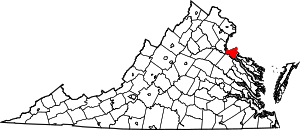Dahlgren, Virginia
| Dahlgren, Virginia | |
|---|---|
| CDP | |
 Location in King George County and the state of Virginia. | |
| Coordinates: 38°20′10″N 77°3′3″W / 38.33611°N 77.05083°WCoordinates: 38°20′10″N 77°3′3″W / 38.33611°N 77.05083°W | |
| Country | United States |
| State | Virginia |
| County | King George |
| Area | |
| • Total | 1.1 sq mi (2.9 km2) |
| • Land | 1.1 sq mi (2.9 km2) |
| • Water | 0.0 sq mi (0.0 km2) |
| Elevation | 20 ft (6 m) |
| Population (2010) | |
| • Total | 2,655 |
| • Density | 2,400/sq mi (920/km2) |
| Time zone | Eastern (EST) (UTC-5) |
| • Summer (DST) | EDT (UTC-4) |
| ZIP code | 22448 |
| Area code(s) | 540 |
| FIPS code | 51-21008[1] |
| GNIS feature ID | 1465571[2] |
Dahlgren is a census-designated place (CDP) in King George County, Virginia, United States. The population was 2,655 at the 2010 census, a large increase from the 997 reported in 2000.[3] The community is located within the Northern Neck George Washington Birthplace American Viticultural Area winemaking appellation established by the United States government.
History
Since 1918, Dahlgren has been the site of a U.S. Naval base named for Rear Admiral John A. Dahlgren. It was then the "U.S. Naval Proving Ground" but was renamed, after 1950, "U.S. Naval Weapons Laboratory", in 1974, the "Naval Surface Weapons Center","in 1987 the "Naval Surface Warfare Center", and around 1990, as the "U.S. Naval Surface Warfare Center Dahlgren Division (NSWCDD)". In 2006, it was renamed "Naval Support Activity-South Potomac (NSA-SP)", with NSWCDD becoming a tenant command of the base. The "U.S. Naval Space Surveillance Systems" command was located at that base, but that responsibility was transferred to the Air Force in 2004.[4] The AEGIS Training and Readiness Center is currently a tenant command at NSA-SP. The 1.7-mile long, narrow two-lane Governor Harry W. Nice Memorial Bridge funnels interstate traffic across the wide Potomac River at Dahlgren, offering an alternative to using Interstate 95.
Geography
According to the United States Census Bureau, the CDP has a total area of 1.1 square miles (2.9 km²), all of it land.
Demographics
As of the census[1] of 2000, there were 997 people, 456 households, and 260 families residing in the CDP. The population density was 885.2 people per square mile (340.7/km²). There were 510 housing units at an average density of 452.8/sq mi (174.3/km²). The racial makeup of the CDP was 70.31% White, 25.28% African American, 0.30% Native American, 1.50% Asian, 0.10% Pacific Islander, 0.60% from other races, and 1.91% from two or more races. Hispanic or Latino of any race were 1.71% of the population.
There were 456 households out of which 24.8% had children under the age of 18 living with them, 41.2% were married couples living together, 11.0% had a female householder with no husband present, and 42.8% were non-families. 36.8% of all households were made up of individuals and 11.4% had someone living alone who was 65 years of age or older. The average household size was 2.19 and the average family size was 2.85.
In the CDP the population was spread out with 23.7% under the age of 18, 7.9% from 18 to 24, 30.6% from 25 to 44, 20.9% from 45 to 64, and 17.0% who were 65 years of age or older. The median age was 37 years. For every 100 females there were 96.6 males. For every 100 females age 18 and over, there were 95.6 males.
The median income for a household in the CDP was $49,545, and the median income for a family was $53,500. Males had a median income of $45,714 versus $21,029 for females. The per capita income for the CDP was $25,928. About 7.6% of families and 8.5% of the population were below the poverty line, including 12.7% of those under age 18 and 10.5% of those age 65 or over.
References
- 1 2 "American FactFinder". United States Census Bureau. Retrieved 2008-01-31.
- ↑ "US Board on Geographic Names". United States Geological Survey. 2007-10-25. Retrieved 2008-01-31.
- ↑ Virginia Trend Report 2: State and Complete Places (Sub-state 2010 Census Data). Missouri Census Data Center. Retrieved 2013-05-19.
- ↑ Wagner, Gary R. "Navy Transfers Space Surveillance Mission to Air Force". U.S. Navy.
External links
- Center for Surface Combat Systems
- AEGIS Training and Readiness Center
- Naval Surface Warfare Center, Dahlgren
- Journal newspaper, covering Dahlgren and King George
